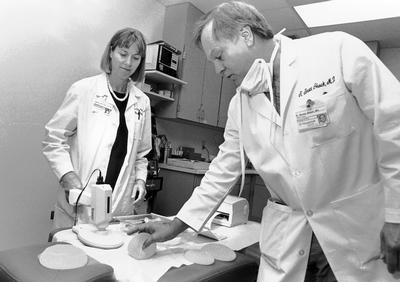Soybean oil tested as implant filler

Dr. Bruce Shack and clinical research specialist Sharon Polis examine new breast implants filled with soybean oil instead of silicone. Photo by Donna Marie Jones.
Vanderbilt University Medical Center is one of 40 medical centers in the United States and Canada participating in an investigative study designed to test soybean oil breast implants as an alternative to silicone implants.
The quest for alternative implant fillers is a response to ongoing concern about the health implications of using silicone implants. They have been associated with serious health problems in women, but there has been no medical proof that the implants cause those health problems.
The FDA is currently investigating these health complaints, and the use of silicone implants are restricted to reconstructive use until the investigation is complete.
"People were frightened by what they were reading or hearing, which was very unfortunate because it was really the Chicken Little story," said Dr. R. Bruce Shack, professor and chair of the Department of Plastic Surgery. "With a lot of very intense medical investigation, there is still no evidence that silicone implants cause illness. But nevertheless, the number of people coming in to physicians offices requesting breast augmentation or reconstruction with implants fell off to almost nothing because people were frightened by what they were reading or hearing."
FDA regulations limiting the use of silicone implants will most likely be lifted as the results of the studies are completed, Shack said.
In response to the scare, researchers and manufacturers began to look at alternative fillers. Saline-filled implants are often used, but the feel is not as natural as the silicone gel-filled implants, Shack said.
The silicone gel is manufactured to have a weight and density similar to normal breast tissue. Saline implants feel much like a water balloon; and oil implants fall somewhere in between, since oil is lighter than water. The oil in the implants is the consistency of cooking oil.
"Both the gel-filled and saline-filled implants are good devices, but there is no such thing as the perfect implant," he said.
One of the problems with both gel and saline-filled implants is that they are radiopaque, which means they do not allow for adequate transmission of x-rays during a mammogram.
"When a woman with implants has a mammogram, the implant will partially obscure the breast tissue and prevent the radiologist or mammographer from getting an adequate look at the breast," Shack said.
However, there are no proven cases where breast implants have been proven to delay the diagnosis of breast cancer, Shack said.
The search for a filler that is radiolucent led researchers to fatty substances, such as soybean oil, which allows X-rays to pass through, Shack said.
"Fat is known to be radiolucent. If you look at fat on an x-ray, it's clear, so oils are the obvious choices for these implants," Shack said, adding that peanut oil is also being tested at some laboratories for use in implants.
The filler is a purified triglyceride derived from soybeans. It has been used in Europe for the past five years, and in the United States for two, said Sharon Polis, clinical research specialist in Plastic Surgery. About 200 patients, a very limited number, were used for the first study.
The implants come filled with soybean oil, but at VUMC, the shells are drained prior to insertion, rolled into a cigar shape, then unfurled into the incision pocket. The bags are then filled by a catheter with the soybean oil. This method allows for a smaller incision, and thus a smaller scar, which is especially beneficial in breast augmentation procedures, Shack said.
Another feature of the soybean oil implants is a computer chip, the size of a grain of rice, within the implant that can be read like a bar code to gain important information. When a scanning machine is run across the implant, a bar code prints out information revealing the type of implant, the manufacturer and the product's lot number.
"It's a high-tech touch and an important one because many women who go in for follow-up checks years later have no idea what kind of implant they have or, in many cases, even who did their surgery," Shack said.
Before the implants can be approved by the FDA, they must be tested in pre-market clinical trials, like the current study at VUMC. There have been 16 women enrolled in the study at VUMC ‹ eight for augmentation or cosmetic procedures, and eight for reconstructive surgery following either a mastectomy or a breast deformity.
The women will be followed for three years.
VUMC has long been an active participant in breast implant studies. Both Shack and Dr. Kevin F. Hagan, assistant professor of Plastic Surgery, have been actively involved in implants and implant research for years.
VUMC is also currently participating in a Plastic Surgery Education Foundation Study, a survey involving women who have had implants removed. The survey is intended to find out their reasons for removal and how they feel about themselves after removal.
"With women who have implants, there is more than a 90 percent satisfaction rate," Shack said. "These days, it's hard to find anything with a 90 percent satisfaction rate."













